Review: 1/48 scale ICM 48232 Junkers Ju-88 A-5 kit review – Part 1 of 2
Well finally... Here it is. I have been trying to get this article done for a while. There have been a few "technical difficulties", but we managed to get past that with help from some friends. More on that later...
This review will have to be written in two separate parts, due to the large number of photographs ( I have 80 pictures for these two articles), I will be posting on the subject. Sorry for the inconvenience of having two parts, but I will be able to cover this kit in more detail this way. My goal for this two part series on the Ju-88, is that this article will hopefully allow you to come to a more informed conclusion on your own.
There have been several reviews of this new tool ICM kit on various websites. Some of these reviews report the kit as being very good, while other reviews state there are a few problem areas with some inaccuracies.
Keep in mind I'm not an expert on the "88" by any means, nor do I claim to be. I hope that others with a more detailed knowledge of this plane type will comment below, and help to make this article even better for all of us.
So here we go...
Much has been written about the Junkers Ju-88. It was the "go to" work horse for the Luftwaffe during WW2. It was used for all kinds of duties. From being a Dive Bomber, to a dedicated Night Fighter, to a composite "Mistel" flying bomb being controlled by a parasite Bf-109 (or FW-190), to a regular level bomber, the Ju-88 did it all. Some even had fake glass painted on the solid nose cap to represent it as a bomber type, when it was a true fighter version. I'll bet this came as a nasty surprise to the unsuspecting souls that encountered it.
As such duties evolved, so did the plane. It underwent a series of changes to reflect the mission required of it. Some of these changes happened mid stream during a production run for a specific type. This has caused some planes to be produced with options normally not available on the standard versions being produced at the same time.
To compound things even further, the Luftwaffe had a common practice of rebuilding older and damaged or salvaged airframes.
Here's a hypothetical example:
During this "rebuilding" process, a plane was originally constructed as an early version of the short wing Ju-88 A-1. The plane was rebuilt, and now "looks" like a Ju-88 A-5 with longer wings, but could possibly still have some of the earlier A-1 parts inside the airframe.
Occasionally these airframes were brought up to date in the field with factory supplied conversion packages. These packages typically were for crew armor updates or weapons installation, for things like flexible MG's or underwing mounted SC bomb racks.
What all of this boils down to is this. Check your references very close if you want a truly accurate Ju-88.
The A-5 actually entered service earlier than the A-4, due to problems with getting the more powerful Jumo 211J engines.
Here's a short and simple chronological order showing the development of the early Ju-88's:
Ju-88 A1 The first production model. It had shorter wings. Equipped with Jumo 211B-1 V-12 liquid cooled engines, later replaced with 211 G-1's of similar power, rated at 1,200 horsepower.
Ju-88 A-5 Based on the A-1, but with longer outer wing panels as pictured above. The wings were now 5 feet 4.5 inches longer overall. There was also a change with the ailerons. Instead of being fabric covered, they were now metal covered. The ailerons were also inset into the wing tips. The pilots and crews liked the new changes, since the handling was improved.
Fitted with Jumo V-12 liquid cooled B-1, G-1 or H-1 engines. All produced 1,200 horsepower on takeoff.
Ju-88 A-4 same external dimensions as the A-5, but with different engines. Initially built with Jumo F-1 engines of 1,340 horsepower at takeoff. Later fitted with the Jumo V-12 liquid cooled J-1 or J-2 series engines (as originally intended), once these became available in numbers. These "J" engines made the same horsepower, rated at 1,340 for take off.
The A-4 was the most produced version of the 88 family.
Now that you know more about the background behind this work horse, we can get to the model.
The Ju-88 has been manufactured in 1/48 scale by various manufactures over the past years. AMT, Dragon, and Revell are the ones that come to mind immediately. The Revell / Pro Modeller kits are supposed to be re boxed Dragon kits, with upgraded or re tooled parts for the cockpit and interior pieces.
However, this is the first time that one has been done as an A-5 version.
The plane is depicted with a nice artists rendition of a Junkers 88.
The lid fits very snug on top of the underlying white cardboard box that contains the plastic parts. The box lid fits so tight that you can accidentally tear the corners if care is not taken removing the box lid. One you remove the lid, there is a folded flap that must be opened to get to the plastic bits inside. These white cardboard boxes are sturdy.
Once you open the folded lid, this is what you will find.
A clear re sealable self adhesive type plastic bag containing all of the plastic parts inside.
The clear plastic parts are also packaged inside the main bag. The clear parts also have their own dedicated re sealable self adhesive type plastic bag. This bag is much smaller, and protects the clear parts from scratches.
At the bottom of the box you will find the kit instructions. They are written in typical ICM fashion. Two languages are used, Cyrillic and English. The front cover page has a short history of the type, and specifications for the plane. Metric measurements are used for the specifications.
The instructions are printed in color and on glossy paper. The construction booklet is 24 pages long. There are 103 construction steps listed.
At the bottom of the front cover page you will see the paint reference chart. The colors are called out by name and Model Master numbers. Besides the name associated with the color, RLM numbers are also used for the typical Luftwaffe colors of RLM 02, 04, 65, 66, 70, and 71, (all of which are used during the construction process).
Each color is assigned an alphabetic letter ranging from "A" to "P". There are also universal building symbols posted here just below the paint reference chart. These symbols are used for things like "Do Not Cement", "Optional", "Make 2 Pcs." and so on.
The next page of the instructions are for parts identification. The few parts that will not be used for this version are shaded with a light red / pink color. The plastic trees are shown here and are labelled "A" through "F". There are two of the "E" trees provided in the kit. The "F" tree is the clear parts.
Oddly the parts are not shown with a corresponding number. The pictures of the parts trees are very good, so you shouldn't have a problem determining what part you are looking at.
A nice set of decals are provided. Four different planes are depicted. My set was in register and the colors looked good to me. The carrier film was very minimal and the finish of the decals had a flat appearance to them. In other words... They look good.
The bad is that no Swastikas are provided...Not even half sections that don't look the part until they are positioned properly on the model. The PC police will therefore not be offended. If you want them, they will have to be sourced elsewhere. I just thought I would mention it.
There are stencils included in the decal set. There is enough for one aircraft. The instruments are also provided as a one piece decal.
The Ju-88 A-5 was equipped with a deployable dive brake that was mounted under the wing. When you build your kit, I would recommend applying the underwing cross before installing the dive brake slats.
A separate decal that is used on the deployable dive brake, was provided.
I have never used ICM kit decals, so I can not comment on how they will work.
A stencil placement guide is provided. This stenciling guide is also used to depict the typical Luftwaffe "Splinter" style camouflage. The upper colors of RLM 70 and 71 are shown with a slight difference in a shade of black / gray.
These colors are close in appearance and for me it's a little hard to tell where the 70 stops and the 71 begins. For others this may not be too bad. I have seen much worse...
As mentioned earlier, there are four planes that can be modeled using the kit supplied decals. The first two are shown in this photo below:
- "L1 + AM" from 4 / LG 1 in France, August 1940 RLM 70/71 over 65
- "L1 + GN" from 5 / LG 1 in Greece, May 1941 RLM 70/71 over 65
- "4D + LN" from 5 / KG 30 in Finland, Autumn 1941 RLM 70/71 over 65
- "F1 + AS" from 8 / KG 76 in Russia, December 1941 Winter White over RLM 65
Once you open the plastic bag, these are the parts you will find inside... I have placed a steel ruler next to them to give you a size reference. The ruler measures 12 inches overall or approximately 305 MM.
Let me start off by saying these parts are molded very crisp. The details are excellent, and no flash is present. This should be expected since this is a new tool release. It also looks like various other later versions of the Ju-88 will be available soon, using some these plastic trees as a base to start with.
The "A" parts tree. This contains the main fuselage halves, elevator assemblies and some other bits.
The "B" tree, which is the main wing panels.
The "C" tree, containing the engine nacelles, VDM propellers, radiator faces, rudder and fin, etc.
The "D" tree, consisting of many smaller parts. This one also includes parts for the main landing gear.
The "E" trees. There are two of these provided. These contain the engines, (which are little jewels), engine mounts, bombs, and MG's. Various other bits are included as well.
This is the clear tree, listed as the "F" parts tree on the instructions. There are various options to choose when you build your kit. The choices will include different rear gunner, gondola and nose sections. These choices are marked out during the construction process.
The clear parts are thin, and look nice. They are very transparent.
Now we get into the "Bolts and Nuts" of the kit...
I have been using three books as a reference guide.
First up is "Warplanes of the Luftwaffe", Edited by David Donald.
Next we have "Warplanes of the Third Reich", by William Green. This book goes into the Ju-88 family in depth.
last is the Squadron Signal "JU-88 In Action Part 1" Series by Brian Filley. This book specializes on the early versions. It also has quite a few illustrations that show the differences between versions.
They are all excellent sources for information on the Ju-88 series of planes.
One of the areas that received some complaints on other online reviews is this section. It's the radiator as provided by ICM.
The online complaints stated that this part was molded without having the air intake openings that the A-5 had.
This is valid.
However, this closing off on the air intake may have been done as a compromise with engineering to help with the kit details for the engines. There is some plumbing mounted very close to this location behind the radiator face. If you look very close at the photo I provided, you will notice the gray plastic is thin in these two air intake locations that were left sealed off by ICM. The thin areas look like a rounded part will eventually be glued in position here on the back side of the radiator face.
This could very well explain the closed off air intakes as molded by ICM.
I will try to open my radiator face, and will know more later about this once the actual construction is started.
Here is a drawing that illustrates the air intakes. It also shows the main differences between the A-4 and A-5 engines. Also note the A-5's had thin chord VDM metal propeller blades.
Most of the later A-4's had the wider paddle blade VS-11 wooden composite props, but some were delivered with the all metal thin chord VDM propellers. The wide blade VS-11's used a different larger spinner than the narrow metal VDM propeller. So here again, please check your references. This may also explain some of the talk online about the spinner not being exact.
It may be someone comparing a drawing of a plane with a wide blade VS-11 verses a narrow blade spinner from a metal VDM. I'm just guessing on that one.
Was the wider VS-11 ever used on a Ju-88 A-5 ? I honestly don't know.
Meanwhile here's a picture of the kit supplied narrow blade VDM prop and associated spinner. These parts are very nicely molded. No sink marks, mold seams or flash is present. You can look at these pictures and judge for yourself.
Another major visible difference is the later A-4 had a distinct air intake that ran along the bottom of the cowling. The earlier A-1 and A-5's did not have this feature.
Lastly the exhausts were slightly different between the A-1, A-5 and A-4.
Here's a cool photo showing how a crew (flying in an A-5) returned home after throwing a prop. The Ju-88 was pretty rugged... This amazing photo shows the radiator face details.
Since we are talking about the radiator face and cowlings, lets venture inside to the Jumo engines and exhaust.
As I mentioned before, these engines are little kits in themselves. Here the instructions show some of the details.
If you look close, you will see the exhaust is slightly different from Port to Starboard side of the engines.
The reason behind this is the real plane had an aerodynamic fairing added to the rear exhaust pipe openings on the Port side. This fairing shielded the last two exhaust stacks as seen in the photo above.
There was a very slight difference between the exhaust used on the A-5 and the later A-4. I believe this had something to do with the style of the exhaust shield. There is a drawing posted above that shows this. You really have to look hard to see the differences. It's very minor, but it is there.
From what I see in the kit parts, it's possible this A-5 has the later style A-4 exhaust.
This may be another small error, but I am not going to officially call it until I have built mine.
The kit exhaust parts are made up from two pieces. There is an upper and a lower half to each exhaust pipe. From looking at the parts on the tree it's hard to distinguish for sure if this is indeed a small error. I will know more about this once construction is started.
Here's a photo of the kit exhaust parts. If this possible small error bothers you that bad, I'm sure there is (or will be) a resin replacement made by someone.
Going on the engines:
Here is the bare inverted V-12 Jumo block. It has been molded rather well, and is two pieces.
The intake manifold is a separately molded part, and is detailed just as nice as the block is.
The engine bearers / motor mounts look very good too.
Once you add the supercharger and associated plumbing, (shown in this photo below),
you will see that it will be rather easy to display this model with the engine access panels off. This will give the builder some nice options. I can see some dioramas being made as a Luftwaffe maintenance scene.
A scratch builder could really go wild with these engines and make a show stopper. It's almost a shame to cover them up ...
However, if you don't want to detail your plane in that manner, you will still have to assemble and install the basic engine block, as it serves as a locate for the exhausts, which will be visible.
You have choices... ICM provided not one, but TWO beautiful Jumo engines in this kit.
Remember at the very beginning of the article, when I mentioned "technical difficulties" ?
Well here's the story behind that... My kit instructions had a missing page ! The very center page was missing... Mine went from page 10 and jumped over to page 15 as seen in this photo below.
I don't know if this was a one time error, or if there are others out there like my sample. From talking to several persons about it later, they had not heard of this happening before. So hopefully this is a single event.
In any event, there are a lot of very important steps that are covered on these pages. I didn't want to "wing it", so I started making some phone calls trying to see what my next steps would be. This eventually had me talking with Tom Fox, who is the Customer Service Manager at Squadron Mail Order, who are a distributor of ICM kits here in the U.S.A.
Tom went and personally checked their inventory warehouse at Squadron to see if he could locate a set of instructions for me. Unfortunately Tom's suspicions were right, and the shelves were bare. No ICM 1/48 scale Ju-88 A-5 kits were left.
On the bright side, Tom told me they were expecting an order to come in sometime in the near future, but he didn't want me to have to wait that long.
So my friend Tom contacted ICM directly, and had a set of instructions sent via email as an attachment. The next day I had a nice set of instructions... for the new tool Heinkel He-111 !
This was not good... 🙂 So I started urgently working on a plan "B".
Meanwhile Tom was busy talking with ICM about the problem...
So I contacted a fellow Imodeler about my dilemma. I got in touch with Robert Paschall, who also owns this kit. Robert advised that he would send me a copy of the missing center pages, adding that he had to scan them first so he could send them as an email attachment.
The very next day I had the missing pages. Robert came through like a Champ.
All was good again ! So Robert, if you are reading this, a great big THANK YOU goes out to you buddy...
Here are the missing pages. I am posting them here just in case any of you out there have the same problem I did.
Here's page 11...
Page 12...
Page 13...
and the last page... #14
As my luck would have it, guess what ? The very next day Tom from Squadron came through. He was able to get me the missing pages for my instructions. (They were sent as an email attachment too).
Now that is some good customer service ! This is especially true since I thought the instructions may not be available since the kit is almost two years old now.
Tom Fox, if you are reading this, I owe you a great big THANK YOU too...
Meanwhile back to the review.
The A-5 and early versions of the Ju-88 A4 had the same rudder. It was in the later part of the production run the rudder was changed. Here is a drawing below, that explains the differences I'm talking about. It's in reference to the hinge line and the rudder counter balance.
ICM has done a very good job molding the rudder... I am fairly certain the rudder was metal covered. I would like to hear more about this from an "88 Expert".
From what I have seen and described to you so far, this kit looks to be very good, and is molded very well. It also appears as if it will build up much easier than the Dragon kits (and the R/M Pro Modeler kits too). My understanding the Pro Modeler kits are Dragon kits that were re boxed with new cockpit and interior parts.
Is this kit perfect ? The simple answer is "No"...
But how many perfect kits do you know of ? The honest answer is none.
Are there some minor errors with this one ? Yes a few that I have mentioned so far. Will these keep me from wanting to build this kit ? Absolutely not. In fact, the more I look at it, the more I want to start cutting plastic and gluing parts...
Please keep in mind that I have not compared the dimensions or outlines to scale drawings. Someone else can do that. Is it right on the money measuring in at a scale wingspan of 65 feet 7.5 inches ? I don't know... I can't answer that one for you.
I can tell you this. So far I am impressed with the quality of this kit, even with it's errors that I pointed out.
In fact I'm seriously thinking about purchasing a newer ICM 1/48 scale release as a the desert version.
It's the Ju-88 A-14 "Tropicalized" , and would be perfect for the Kasserine Pass Group Build. 🙂
To be continued...
Here's the link to part 2
In closing, I wish to thank my friends who assisted me with this review. Without their help, this article wouldn't exist. Seriously, thanks guys !
They are Robert Paschall, a fellow Imodeler member and friend, who provided the missing center pages of the instructions.
Tom Fox, the customer service manager from Squadron Mail Order, who tirelessly searched for the missing pages, and came through with a second set for me…….
and Pedro L. Rocha, another fellow Imodeler member, Ju-88 connoisseur, (and new friend of mine), for asking the questions he did after I posted this article in it's original form.
This kit is “Highly Recommended” by me…………………..even with the few things I pointed out during the two reviews. I'm sure that someone with a little effort, could fix these small errors easily.
Thanks for reading this.
and as usual, “Comments are Encouraged”.
REFERENCES:
- “Warplanes of the Luftwaffe”, Edited by David Donald.
- “Warplanes of the Third Reich”, by William Green.
- Squadron Signal “JU-88 In Action Part 1” Series by Brian Filley.








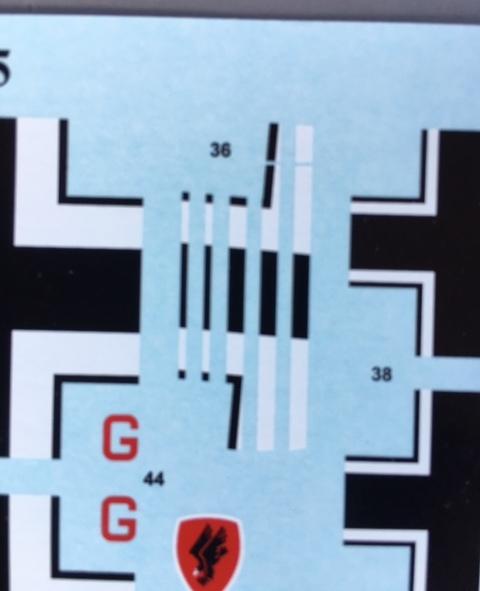











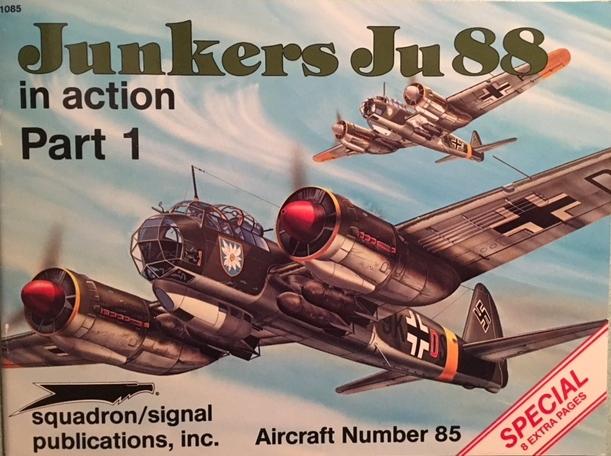








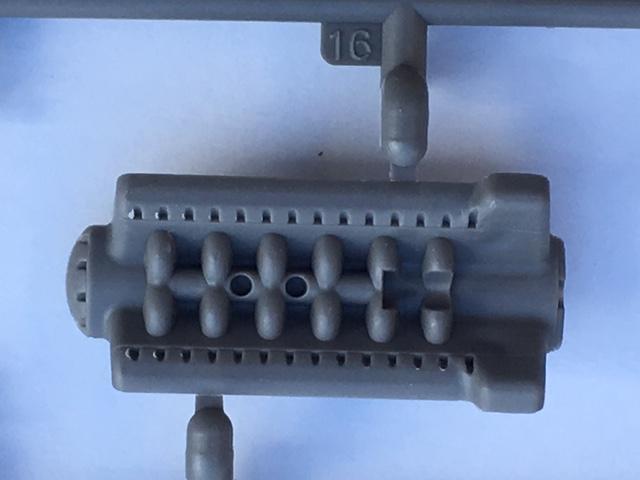






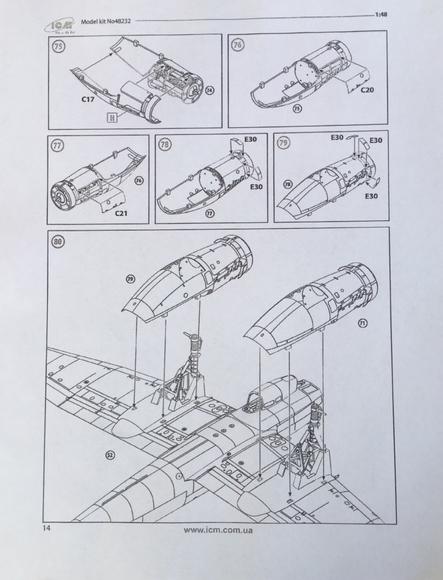



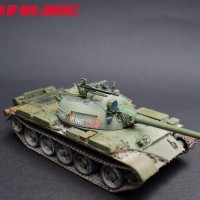

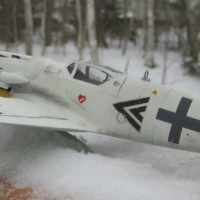
Thanks Louis for this excellent review. The JU88 is my favorite German WW2 bomber and ICM is actually gaining respect as a kit manufacturer! One day I will meet the JU88 head-on after my THUD.
You are welcome my friend. I like the 88 too, but it's a toss up for me between this Junkers version and the Heinkel He-111. I'll be looking forward to seeing you work your magic on one. I agree, during the last few years, ICM has improved by leaps and bounds. I think they can give some Asian companies a good run for the money now...
Yes, true. In a way, DML became a bit too large on armor so to say, which I know best. They started off at good prices a decade ago at good quality molds and grew steadily in market share. The most recent kits are no longer comparable to the modeler fun you had with those ten years ago even though detail has been further refined.
You get DS tracks now instead of magic tracks and less other extras while the kit unit cost and amount of non-used styrene has increased. It s in this gap that others like AFV, Takom, Zvezda and ICM now jump you could say, offering great value for (half the DML) money albeit as a lesser known brand.
I personally don t buy the brand but rather the kit quality based on thorough research of reviews such as this one. Even if the manufacturer of a good kit happens to be Ukrainian, he gets equal chances to win my respect and money! 🙂
Cheers!
I like Dragon's armor kits too, and have quite a few of them in the "stash". They make some kits on subjects you normally wouldn't see of some "one off" and prototype versions. I really liked the "Smart Kits', when they came with metal barrels, and "Magic Tracks". I am a big fan of individual track links. You just can't get the proper look of track sag using a single one piece track. One piece tracks are OK to use for US tanks, since they tend to run with very little or no track sag at all. However on German and Soviet Armor builds, individual links are the best way to go in my opinion. What they all really should do is include BOTH kind of tracks in a kit if at all possible. Then the modeler could make their own choice as to how they want to build their model.
I recently purchased an AFV kit of the M-60A1 tank, which is the tank I spent most of my time in as a crew member. Then Dragon came out with a "straight" M-60 with the older style turret... Yes I had to get it too...
Like you, who ever has the best product on the market gets most of my money. There are a lot of great model manufacturing companies now. I recently purchased several Zvezda kits, all WW2 Russian planes in 1/48 scale. In all honesty, they look pretty nice too.
We live in the Golden Age of model building for sure.
Louis, like your previous reviews with the 2 other Luftwaffe medium bombers recently released by this maker, this one seems pretty extensive. Particularly useful are the ups and downs you find in the kits. With the exception of the Heinkel, I am aware of some errors in both this and the Dornier. No doubt you will also mention the cockpit floor being incorrect, but I wonder if ICM did the same mistake with the spinners (being too blunt) as Dragon did with their Ju 88?
Again, no kit is perfect (or almost none ?), and to me these are certainly worth buying
Thank you for the kind words Pedro. So far I have not seen anyone find faults with the new tool He-111 that was just released by ICM. I'm going to get busy with that one very soon... I just can't stand it much longer. 🙂
But just as you mentioned, there are a few things worth talking about on the Dornier and the Ju-88 A-5. I can not say anything about the later Ju-88 releases by this company, since I have not personally seen them up close. I don't want to cast doubt on something that I have only read about. I like to be the judge and make my own choices after I see the facts or have the opportunity to look at the plastic in person.
Yes I am going to mention the floor. Thanks for bringing that up. As far as the spinner are concerned, I haven't checked the kit parts against drawings. Sometimes the drawing can be in error too.
What I like to do is compare them to actual photographs. Even then, there can be a minor difference that is induced by the angles the photo was taken from, and how the camera was positioned. So it's kind of like a medieval alchemist trying to brew up some gold... using copper, lead and tin. 🙂
Like you stated, there is yet to be an absolute "perfect" kit produced. I have several of the older Dragon kits, and some of the Pro Modeler versions of the A-4's. I can say that this kit looks like it will be an easier build. As far as accuracy goes... It looks pretty good too, just not perfect.
The little things we are talking about can be fixed, and for me, they are not a deal breaker. I am strongly considering purchasing the new ICM 1/48 scale Ju-88 A-14. I want to built up a desert version, and that one fits the bill...
Thanks for your comments. I sincerely appreciate them.
PS: If you like my kit reviews, I have a sneak peak teaser for you...
Hummm, this is a juicy one Louis, and one I haven’t seen in the plastic so to speak. Perhaps a comparison with Eduard’s mould could make it even more juicier 😉
That would be good, but unfortunately I don't have an Eduard 109. maybe someone else here does ?
The closest thing I have left in the stash for a comparison is the Hasegawa Bf-109 G-10, a K-4,and a Monogram G-10. All of the other G series 109's I had have been built...The remaining 109's left in the stash are the earlier E and F versions from various manufacturers, such as Tamiya, Hasegawa, and Zvezda.
I'm looking forwards to getting the A-5 soon. For a larger scale try the new ICM Polikarpov I-16 Type 24 in 1/32...it's their first 1/32 kit and it's a gem! (Anmd they're following it up with two more late I-16s, the type 28 and 29, a Polikarpov I-153 AND a Bucker Bu131 Jungmeister!... along with 1/32 figures to match (Luftwaffe cadets, VVS ground crew and pilots).
Thanks for the heads up Brett ! This is good news for sure. They all sound like good subjects to build. The Jungmeister will definitely be on my wish list now...
I sincerely think you will like the A-5 once you get one... I did.
Now I want to get my hands on the newer 1/48 scale ICM ju-88 A-14 desert version.
Thanks again !
Wow...VERY comprehensive review, Louis - I feel like I've got one myself! 🙂
Nice Craig ! That's what I wanted to hear buddy. Thanks 🙂
Comprehensive, detailed, enthusiastic, helpful, nice story (with a happy ending, no less, included), great photos. What more could you want from a review.
Great work, Louis, really helps people like me who are a bit picky about what gets added to the stash. I love the '88' but leaning toward the '111' - that said, I'll probably end up with both...
Thank you David ! I am happy to hear that you enjoyed reading this article.
I am a bit picky with making new purchases too. I am very pleased that I bought this one... and that Heinkel, it sure is sweet ! I'm seriously thinking about starting that one VERY soon, (and a build log of the adventure here to boot). I have a few FW-190's on the work bench that I need to finish up first...
WoW! (Part 1)
Check out part two buddy... I just edited the article, and added some new information and photos about the cockpit floor...
Thanks Jeff !
Great Job buddy, your very welcome!
Thanks Robert. I couldn't have done this without your help... and I sincerely mean this.
Louis,
With 2 Eduard 109 G under my belt, I'm currently waiting the postman to deliver a weekend edition. Perhaps when you review Tamiya's edition...
1 attached image. Click to enlarge.
I just noticed your article... and I really like how your 109 looks. The zig zag finish on the upper surfaces looks spot on. As does the rest of the plane. Well done my friend !
I'll try to get the Tamiya 109 review posted soon. I'll give you a heads up...
I would love to see what you have to say about the new Eduard kit. From what I have read online, it looks pretty nice !
as does your 109... 🙂
I am having a mother of a battle with the Special Hoby version of this! Fitting the floor/cockpit to the upper half is very awkward. The instructions are not that clear as to where to position the side panels to the cocpit walls and I think that is the root of my problems.